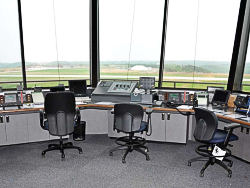Out of the Ozarks
 |
The first challenge was getting power and water to the remote 922-acre site so that work could begin, notes Renita Mollman, P.E., LEED AP with engineering firm Burns & McDonnell. "The airport is pretty much out in the middle of nowhere, so we had nothing out there to service the airport," Mollman says. A wastewater treatment facility and water well with pump station were consequently constructed.
Down in the Dirt
The local terrain provided challenges to crews' earth-moving efforts. Burns & McDonnell followed a detailed erosion control plan and the Missouri Department of Natural Resources had close oversight on the work, Mollman specifies.
 |
Of the total 12 million cubic yards of earth that was moved, about two million was rock and the rest was a soil-rock mixture. "Nothing down there is pure soil," Mollman says.
McAninch Corporation of Des Moines, IA, managed the earth-moving preparations - not an easy task given the amount of work to be done in roughly 20 months. "We had what we thought was a pretty restricted construction schedule," Mollman says. "McAninch got out front very early with the earth works and completed it in about eight months from starting."
Even with the aggressive timeline, nothing - construction, operations or safety - was sacrificed, specifies airport director Jeff Bourk. "We met every FAA guideline and design standard that any airport would follow that takes federal grants, except we're paying for it all," Bourk says, noting that Branson Airport is Part 139 certified and meets all the criteria and guidelines of other FAA-certified airports.
More Hurdles Ahead
Site work also included construction of two 400-foot-long, 80-foot-high bridges and a three-mile access road to provide access to the airport site. HDR Engineers handled the roadway and utility design.
An active transmission line running through the airport property also added complexity. For six months, contractors had to work carefully around it to ensure it was not disturbed. The power company that owns the transmission line eventually relocated it, at the airport's expense.
The airport site was "surprisingly clean," according to Mollman, but some stream mitigation was needed. In turn, the DNR allowed the airport to preserve an area of other streams on airport property that cannot be disturbed in the future.
Dirt work started in July 2007 and was completed in roughly nine months, Berven reports. "We basically took a cow pasture and turned it into a 9,000-foot strip of flat land," he says. The flat land now accommodates a 7,140-foot long runway able to accommodate aircraft up to a Boeing 767. It is designed so that it can be extended to 9,000 feet if necessary in the future.
The single runway is expected to see 300,000 enplanements in the first year, with growth over five years to boost the total to about 500,000 enplanements. Even though it is just a single runway, Berven says, it can land a lot of aircraft.
 |
A Different Role for FAA
According to Mollman, working at Branson was not markedly different than working on a publicly funded airport. While the design of the airport had to comply with FAA rules and regulations to receive Part 139 certification, engineers had "a few more liberties" because FAA did not fund the project, explains Mollman.
"We didn't have near the reviews and public hearings that you would have to go through if it were FAA-funded," she comments. "Although we did all those steps just to make sure that we were in compliance, we did not have to do them to the extent that the FAA would require."
Since the airport did not have an "advocate" within the FAA to guide the project, Mollman says she personally learned a lot about processes and the steps from design and construction to commissioning and opening. Despite a lack of a financial stake, the FAA was a "great partner," she says.
Berven agrees that the FAA was a tremendous asset in getting the airport ready for an on-time opening. "From doing the environmental assessment to charting the approaches and getting flight check out here to inspect our instrument approaches," he says. "It was an amazing amount of coordination to get everything done in a year-and-a-half."
Original plans for BKG did not include an air traffic control tower, but utilization estimates and radar coverage in the area prompted its addition.
Construction of the tower was an interesting process, says Berven. Branson provided the FAA with five potential sites. Given the 50-foot height difference between the north and south ends of the airfield, the 42-foot tower was eventually built on top of a hill.
As of mid-August, Branson's air traffic control tower has operated under the FAA's Contract Tower Program by Midwest ATC. The current program ends Sept. 30 and is subject to rebidding on Oct. 1. Midwest ATC, which operates towers at 243 airports, is one of five vendors in the program, notes Bill Ellis, the company's vice president of aviation services.
FREE Whitepaper
Fairbanks International Airport Baggage Transport Conveyor Enhanced With Mod Drive™ System
Airports face a host of unique industry challenges, such as meeting efficiency regulations and seeking out the best maintenance practices to reduce costs and keep operations flowing. In today’s current economic climate, any potential cost savings can go a long way.
In 2019, Alaska’s Fairbanks International Airport (FAI) sought to modernize its equipment and operations. They were dissatisfied with the performance of the gearmotors on their baggage transport conveyors and began searching for new suppliers. Regal approached FAI with a solution that could improve equipment performance and simplify maintenance, with the added benefit of energy cost savings: the Hub City® MOD Drive™ system.
This white paper discusses the hardware deployed, the test results and the annualized expectations for ROI.








